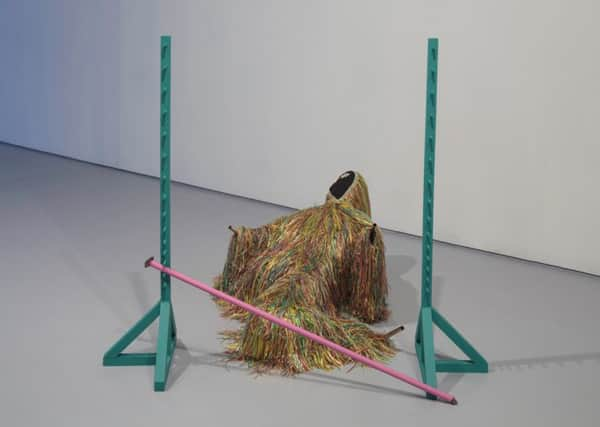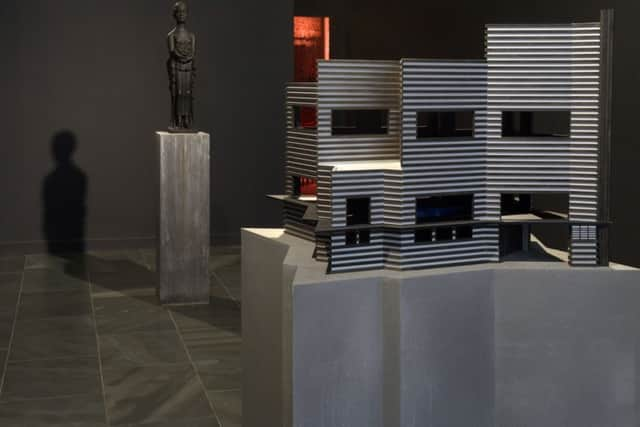Art reviews: Alberta Whittle | Grace Schwindt | Jasmina Cibic


Alberta Whittle: How Flexible Can We Make the Mouth, Dundee Contemporary Arts ***
Jasmina Cibic: An Atmosphere of Joyful Contemplation, CCA, Glasgow ****
Advertisement
Hide AdAdvertisement
Hide Ad

Art which has a big subject to address can sometimes draw from that a sense of clarity and urgency; but not always, as these three exhibitions prove. All by women with international backgrounds, working across a range of disciplines, they are also united by the fact they approach big, weighty themes in elliptical ways.
Barbadian-Scottish artist Alberta Whittle, a graduate of Glasgow’s School of Art’s MFA programme, makes work about the legacies of colonialism and the slave trade. Her show at DCA is her largest to date, bringing together a number of recent works, including the film between a whisper and a cry , made as a result of winning the Margaret Tait Award in 2018.
The 37-minute “experimental film” (why does my heart sink whenever those two words appear together?) collages imagery around these themes, with inspiration from Barbadian poet Kamau Brathwaite and Black Studies professor Christine Sharpe’s work on the weather. The central motif is one of circling – black workers propelling a huge grinding wheel, hurricanes swirling on a weather map, the whirling skirts of dancing women at a black pentecostalist church – even as the film circles around its subject. A dancer makes her own mesmeric performance to Sun Ra’s Enlightenment, and the film circles back to Glasgow, which, of course, has its own shameful slave-trade legacy.
The show begins with Secreting myths, a series of prints in which Whittle’s adaptations of 16th century engravings showing European colonists arriving in the Americas. Whittle has deliberately created “hard to read areas,” in the same way that her film My grandfather, her father – in which her Barbadian grandmother talks about having Scottish ancestry – is hard to hear. It might be a worthwhile reminder of how much of history has been erased, or marginalised, by rich white Europeans, but it also requires patience on the part of the viewer.
Sculpture, on an impressive scale, also populates the show. There is a barbadian chattel house sinking into the floor (perhaps another allusion to the effects of storms), a limbo-dancing figure made of coloured straw (there is a theory that limbo has its origins in the cramped conditions on slave ships) and an imposing Caribbean deity dressed in a patchwork of tartan fabrics and sections of the checked plastic bags often used by migrants.
A new film from the forest to the concrete (to the forest), rushed into the show in response to recent events, makes a more explicit connection between black oppression and climate change. Whittle invites us to watch it sitting on heat-sensitive cushions, wrapped in a blanket printed with her family tree.
And this is an important clue. However disturbing the subject matter, Whittle’s impulse is towards empathy, understanding, consolation, endurance. Her work is full of warmth and patience, and she requests the same qualities – perhaps not unreasonably – from the viewer. She instructs us to breathe, as if we were meditating. There is calm, and there is also celebration: “We are dancing on the ruins,” one of her poems says.
Advertisement
Hide AdAdvertisement
Hide AdFor all the hard-hitting history here, it’s more of a hug than a punch. That might be confusing, even frustrating, if one expects a more direct engagement with the issues. But if you like work which celebrates nuance, complexity and affirmation, it will be right up your street.
The new film by Grace Schwindt, one of the concluding shows in CCA’s performance season, comes, we’re told, from the artist’s “ongoing interest in how public health is perceived and treated, and how mental health is discussed in contemporary society.” The title, Five Surfaces All White, comes from a conversation with her grandfather, in which he described his care home room, and other interviews on how the architecture of health services have informed the work. But this is far from a direct engagement on the subject.
Schwindt, a German artist based in London, takes her “five white surfaces” out into the landscape around Cove Park on the Kilcreggan Peninsula, and works with three performers and a horse to create a meditative 40-minute film. A young woman dances, then slumps across the back of the horse; an older man sits in a rocking chair, plays the trumpet and conducts an imaginary orchestra; a woman sings to the horse (this goes on for quite some time as the patient beast stands there quietly; one has to admire its patience).
Occasional spoken sentences movingly recall her grandfather, but for the most part Schwindt favours other forms of communication – gesture, dance, humming, playing the mouth organ – which lack the precision of words. Not an architectural critique, then, nor a political one (which is also part of Schwindt’s modus operandi). What this film is actually saying is much more abstract and elusive.
Slovenian artist Jasmina Cibic, meanwhile, shows a substantial body of work in the neighbouring space engaging with the subject of the role art – particularly European modernism – plays in the nation state. Again, she shows sculpture as well as film: a scale model of Yugoslavia’s now lost pavilion for the 1929 Barcelona Expo (spliced with elements of Adolf Loos’ 1927 house for Josephine Baker) and a bronze statuette of a woman from the same Expo are the first things we see, starting a conversation about how imagery of the female body is used in this context.
In the main space, two tapestries are being woven by two classical singers, Rosie Lavery and Lea Shaw – at certain times each week they will be in residence, singing to one another as they work about how to build the perfect nation state, their enchanting voices resounding through the space. Then we arrive at the apex of the show, Cibic’s trilogy of NADA films, which explore art, dance, music and architecture.
In the first, violinist Dejana Sekulic appears to “tune” a stringed instrument shaped like a model of an unrealised design for the Yugoslav pavilion at the 1958 Brussels Expo. In the second, five dancers perform scenes from Bartók’s The Miraculous Mandarin, which was performed at the Expo, re-choreographed as a political allergy and filmed in Arne Jacobsen’s beautiful Aarhus City Hall.
Advertisement
Hide AdAdvertisement
Hide AdThe third is a dialogue between three women, Artist, Curator and Nation (Germania), the words taken from discussions and correspondence about Germany’s presentations at World Expos in 1929, 1937 and 1958. It is filmed in two houses by Ludwig Mies van der Rohe.
Cibic’s work is perhaps the more cerebral, the least elliptical, of the three and is beautifully produced with considerable ambition – look out for further work by her at Dundee’s Cooper Gallery next month. However, it is still more meditative than didactic. Like all of these shows, it’s less about conclusions than about opening up a subject, and would benefit from repeated views to make its subtle points.
Alberta Whittle until 21 November; Grace Schwindt and Jasmina Cibic until 13 October